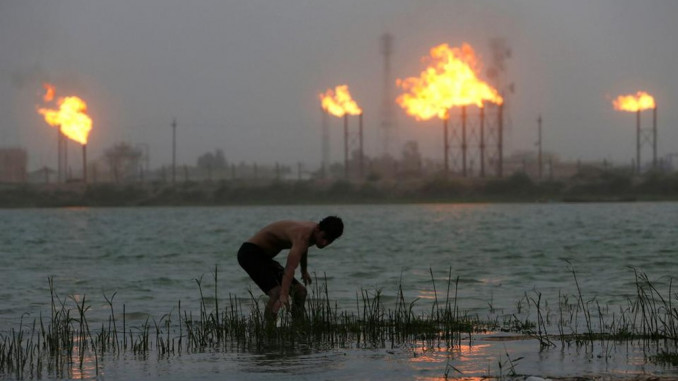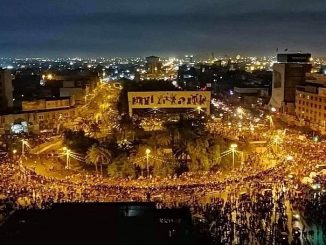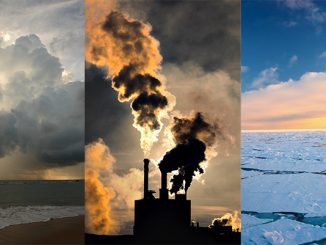
Iraq is environmentally devastated. Due to years of punishing sanctions by the U.S. following the Iran-Iraq war in the 1990s and the 40 years since then of conflicts, most notably the 2003 U.S. invasion and war, the country’s people face the devastation of their health, infrastructure, finances, and homeland.
Iraq is hot and arid. It was made vulnerable to climate change due to the unfettered extraction of oil. The power of the oil industry in the region has led to the deterioration of infrastructure and the displacement and pollution of water resources.
The impact of the war in Iraq in creating this situation cannot be forgotten. The U.S. war on Iraq was a horrific assertion of the power of imperialism in the region. The U.S. government started the war in 2003 after politicians were able to increase U.S. nationalism by pushing lies about “weapons of mass destruction” after the 9/11 terrorist attacks in 2001.
Much of Iraq’s infrastructure was destroyed during the war. The combination of imperialist sanctions, Big Oil exploitation, and war has led to the deterioration of water supplies, sanitation, sewage, and electrical systems.
Though the war officially ended in 2011, American troops have never entirely left the country. Although estimates vary significantly, it is likely that more than 465,000 people died in the war, and possibly many more than that. Even more continue to die every day from poverty and health complications as a result of the U.S. war.
The power of oil in the region has a long history. The Turkish Petroleum Company (TPC), despite its name, was controlled by the British government and dates back to 1912. In 1929 it was renamed the Iraq Petroleum Company (IPC). Meanwhile, ARAMCO and BAPCO had controlling power in Saudi Arabia. Aramco, or Arabian-American Oil Company, was an alliance between the Saudi Arabian government and the U.S. that allowed Standard Oil of California to extract and profit off of Middle Eastern oil reserves. In 2022 Aramco was the 6th largest company in the world by revenue. BAPCO, or Bahrain Petroleum Company, was similarly formed by an alliance between Bahrain and Canada to allow Standard Oil of California to extract oil in Bahrain. In 1936, Texaco joined the agreement as well. The oil monopolies in the Middle East are American and European companies who profit off of extracting Middle Eastern resources at the cost of middle eastern lives, livelihoods, and ecology. They received no invitation from the people there.
In 1970 the Iraqi government nationalized the IPC. In other words, all of Iraq was controlled by one oil company, with ties to the British government, that had a strong influence on the Iraqi government. By 2007, this concentration of wealth and power had developed to the extent that a body called the Federal Oil and Gas Council was created that could block certain laws made by regional governments. This concentration of wealth and power in the region continues – and less equality means more exploitation.
The Fertile Crescent is a large part of what is known today as the Middle East. It was historically known for having a rich, diverse, and thriving environment. Watered by the Euphrates and Tigris Rivers from the north, the area was great for agriculture. But its modern history of bowing to the oil monopolies has led to the complete devastation of the Iraqi ecology and climate.
The process of its drying has been ongoing for many decades. It started with the redirection of the Tigris and Euphrates in the 1950s. It was made worse by dikes and dams built by Saddam Hussein to punish dissident Marsh Arabs in southern Iraq. What little water is left in the region is often polluted by the oil fields. Instead of swampy, wet, and green, now the land is dry, dusty, and hot. It is the world’s 5th most at-risk country in relation to the global climate crisis.
Iraq continues to be rocked by the effects of imperialism. The country is currently experiencing its worst drought in 40 years. In the last 2 years, Iraq frequently has had temperatures passing 120 degrees Fahrenheit. Turkey has several dams on the Tigris and Euphrates Rivers, which then flow south into Iraq, but with significantly less water than was the case historically. These two rivers supply 98% of Iraq’s water, but have decreased by 30-40% in the last few years. For example, the mile-wide Ilisu Dam opened in 2018, reducing Iraq’s share of the Tigris River’s water supply by 60%. The historic marshlands in south Iraq, described as “a natural heritage wonder,” are drying up, displacing communities and leaving behind dead buffalo.
Meanwhile, the high demand for Iraqi oil has led to a wealthy Iraqi ruling class that sacrifices the climate and water resources in favor of the oil industry. Per year, ten percent of the world’s greenhouse gases are attributable to Iraq.
This is largely because of gas flaring. Iraq is the second largest gas flaring country in the world. Gas flaring occurs when natural gasses are burned during the extraction of oil and a highly toxic and polluting mix of substances is released into the environment. The black soot that is released from gas flaring contains carbon dioxide, methane, and benzene among other toxic pollutants. These chemicals are absorbed into the atmosphere through evaporating water, and released as acid rain, which leaves the ground depleted of essential nutrients and pollutes natural water sources.
In the Iraqi city of Nahran Omar, the water sources are so polluted that six percent of the population has died from or currently suffers from cancer or other health conditions. Many of the people suffering from health impacts due to polluted water sources are under the age of 25.
The droughts and aridity in the region currently have led to an increase in the number of sandstorms. In previous decades, Iraq would have experienced two sandstorms per year. Now, some regions of the country are experiencing 272 days of sandstorms in a year. This has led to an increase in long-term respiratory illnesses among people there. In 2022, as many as 10,000 people were hospitalized as a result of sandstorms in Iraq.
Since irrigation in Iraq often depends on rainfall, the drought negatively affects farmers. In fact, 39% of land in Iraq is impacted by desertification and each year the country loses about 100 square kilometers of arable land. When farmers are forced to migrate into the cities as a result of the destruction of arable land, they face an overabundance of people like themselves who need work and a lack of jobs for workers.
After drying up and polluting the environment and, therefore, people’s livelihoods, the oil barons who control the Iraqi region haven’t been bothered to hire local Iraqis, who are desperate for work to pay for their increasing medical bills. There are 100,000 foreign workers in the oil industry in Iraq, and they are usually paid higher wages than are paid to the few Iraqi workers hired alongside them.
The cost of an oil-based economy in the region is the destruction of its ecology and the livelihood of its people as well as war and intensification of the global climate catastrophe. So, who benefits from it? The billionaire, oil-baron-filled ruling class. And who stands to benefit from kicking them out? People left with no land and no work to survive on. In these circumstances, what do we have to lose? We have to fight back.




